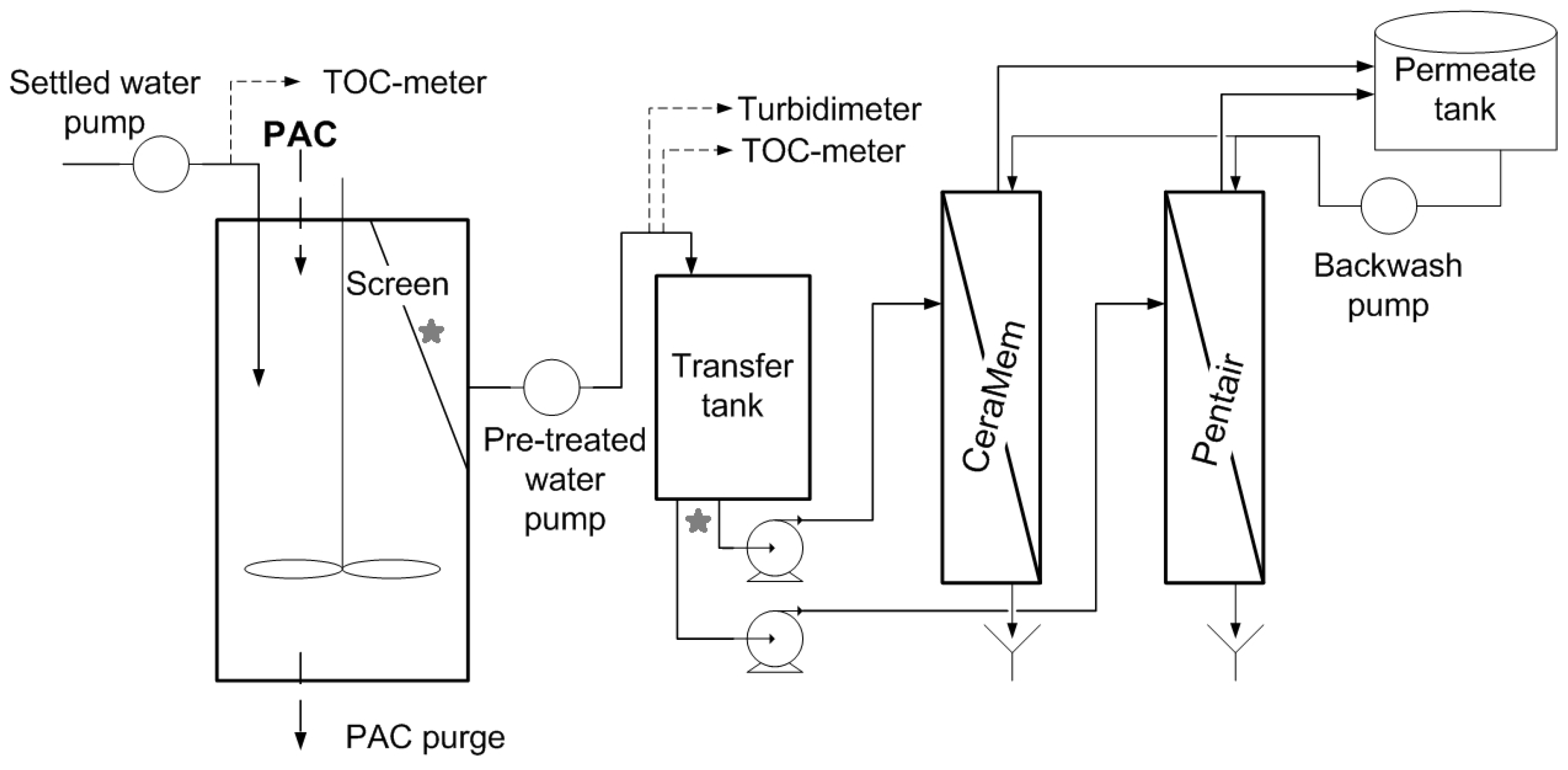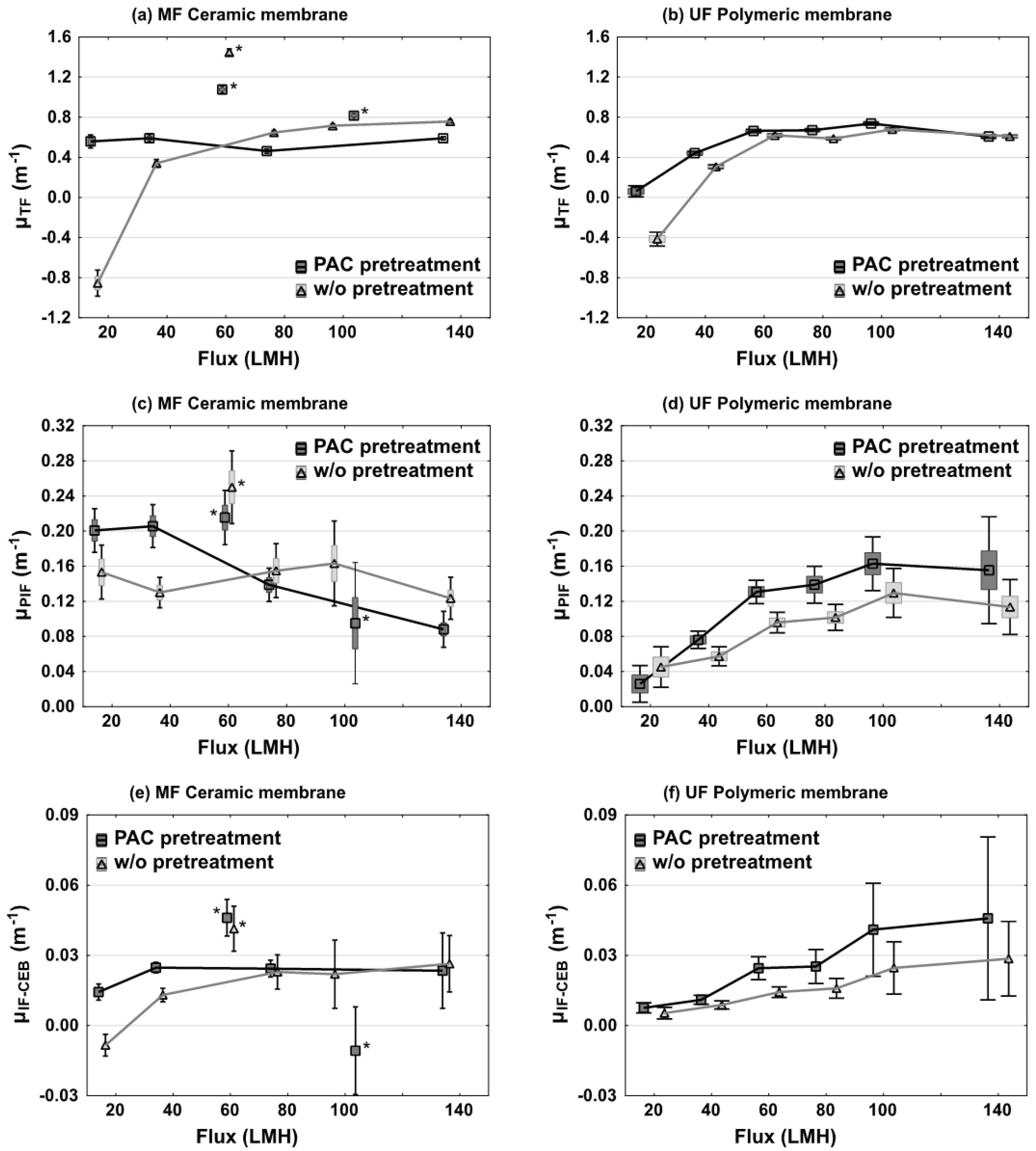Impact of PAC Fines in Fouling of Polymeric and Ceramic Low-Pressure Membranes for Drinking Water Treatment
Abstract
:1. Introduction
2. Material and Methods
2.1. Source Water
2.2. Pilot-Scale Membrane Set-up
2.3. Experimental Design
2.4. Analysis of Fouling Behavior
2.5. Types of Fouling
2.6. Characterization of Foulants
2.7. Measurement of PAC Fines Released from the Carbon Contactor
2.8. Seasonal Variation of Fouling
3. Results
3.1. Feedwater Characteristics
3.2. Seasonal Fouling Variability
3.3. Export of PAC Fines from the Carbon Contactor
3.4. Fouling Behavior
3.4.1. Typical Fouling Data
3.4.2. Total Fouling
3.4.3. Physically Irreversible Fouling
3.4.4. Irreversible Fouling by CEB (IF-CEB)
3.4.5. Irreversible Fouling by CIP
3.4.6. Relative Importance of Each Type of Fouling
3.5. Characterization of Irreversible Foulants in CIP Cleaning Solutions
4. Discussion
5. Conclusions
Acknowledgments
Author Contributions
Conflicts of Interest
References
- Cook, D.; Newcombe, G.; Sztajnbok, P. The application of powdered activated carbon for MIB and geosmin removal: Predicting PAC doses in four raw waters. Water Res. 2001, 35, 1325–1333. [Google Scholar] [CrossRef]
- Stoquart, C.; Servais, P.; Bérubé, P.; Barbeau, B. Hybrid membrane processes using activated carbon treatment for drinking water production: A review. J. Membr. Sci. 2012, 411, 1–12. [Google Scholar] [CrossRef]
- Khan, M.M.T.; Kim, H.-S.; Katayama, H.; Takizawa, S.; Ohgaki, S. The effect of particulate material and the loading of bacteria on a high dose PAC-MF system. Water Sci. Technol. Water Supply 2002, 2, 359–365. [Google Scholar]
- Zhao, P.; Takizawa, S.; Katayama, H.; Ohgaki, S. Factors causing PAC cake fouling in PAC-MF (powdered activated carbon-microfiltration) water treatment systems. Water Sci. Technol. 2005, 51, 231–240. [Google Scholar] [PubMed]
- Takizawa, S.; Zhao, P.; Ohgaki, S.; Katayama, H. Kinetic analysis of PAC cake-layer formation in hybrid PAC-MF systems. Water Sci. Technol. Water Supply 2008, 8, 1–7. [Google Scholar] [CrossRef]
- Leveillé, S.; Carrière, A.; Charest, S.; Barbeau, B. PAC membrane bioreactor as an alternative to biological activated carbon filters for drinking water treatment. AQUA J. Water Supply Res. Technol. 2013, 62, 23–34. [Google Scholar] [CrossRef]
- Khan, M.M.T.; Takizawa, S.; Lewandowski, Z.; Jones, W.L.; Camper, A.K.; Katayama, H.; Kurisu, F.; Ohgaki, S. Membrane fouling due to dynamic particle size changes in the aerated hybrid PAC–MF system. J. Membr. Sci. 2011, 371, 99–107. [Google Scholar] [CrossRef]
- Saravia, F.; Naab, P.; Frimmel, F.H. Influence of particle size and particle size distribution on membrane-adsorption hybrid systems. Desalination 2006, 200, 446–448. [Google Scholar] [CrossRef]
- Lee, S.-J.; Kim, J.-H. Differential natural organic matter fouling of ceramic versus polymeric ultrafiltration membranes. Water Res. 2014, 48, 43–51. [Google Scholar] [CrossRef] [PubMed]
- Kim, H.-S.; Takizawa, S.; Ohgaki, S. Application of microfiltration systems coupled with powdered activated carbon to river water treatment. Desalination 2007, 202, 271–277. [Google Scholar] [CrossRef]
- Campinas, M.; Rosa, M.J. Assessing PAC contribution to the NOM fouling control in PAC/UF systems. Water Res. 2010, 44, 1636–1644. [Google Scholar] [CrossRef] [PubMed]
- Zhang, M.; Li, C.; Benjamin, M.M.; Chang, Y. Fouling and natural organic matter removal in adsorbent/membrane systems for drinking water treatment. Environ. Sci. Technol. 2003, 37, 1663–1669. [Google Scholar] [CrossRef] [PubMed]
- Saravia, F.; Frimmel, F.H. Role of NOM in the performance of adsorption-membrane hybrid systems applied for the removal of pharmaceuticals. Desalination 2008, 224, 168–171. [Google Scholar] [CrossRef]
- Seo, G.T.; Moon, C.D.; Chang, S.W.; Lee, S.H. Long term operation of high concentration powdered activated carbon membrane bio-reactor for advanced water treatment. Water Sci. Technol. 2004, 50, 81–87. [Google Scholar] [PubMed]
- Markarian, A.; Carrière, A.; Dallaire, P.-O.; Servais, P.; Barbeau, B. Hybrid membrane process: Performance evaluation of biological PAC. AQUA J. Water Supply Res. Technol. 2010, 59, 209–220. [Google Scholar] [CrossRef]
- Huang, H.; Young, T.A.; Jacangelo, J.G. Unified membrane fouling index for low pressure membrane filtration of natural waters: Principles and methodology. Environ. Sci. Technol. 2008, 42, 714–720. [Google Scholar] [CrossRef] [PubMed]
- Lee, C.W.; Bae, S.D.; Han, S.W.; Kang, L.S. Application of ultrafiltration hybrid membrane processes for reuse of secondary effluent. Desalination 2007, 202, 239–246. [Google Scholar] [CrossRef]
- Seo, G.T.; Jang, S.W.; Lee, S.H.; Yoon, C.H. The fouling characterization and control in the high concentration PAC membrane bioreactor HCPAC-MBR. Water Sci. Technol. 2005, 51, 77–84. [Google Scholar] [PubMed]
- Li, K.; Liang, H.; Qu, F.; Shao, S.; Yu, H.; Han, Z.-S.; Du, X.; Li, G. Control of natural organic matter fouling of ultrafiltration membrane by adsorption pretreatment: Comparison of mesoporous adsorbent resin and powdered activated carbon. J. Membr. Sci. 2014, 471, 94–102. [Google Scholar] [CrossRef]
- Londoño-Montoya, I.C. Assessment of Causes of Irreversible Fouling in Powdered Activated Carbon/Ultrafiltration Membrane PAC/UF Systems. Civil Engineering. Master’s Thesis, The University of British Columbia, Vancouver, BC, Canada, 2011; p. 56. [Google Scholar]
- Bacchin, P.; Aimar, P.; Field, R.W. Critical and sustainable fluxes: Theory, experiments and applications. J. Membr. Sci. 2006, 281, 42–69. [Google Scholar] [CrossRef] [Green Version]
- Bérubé, P.R.; Lin, H.; Watai, Y. Fouling in air sparged submerged hollow fiber membranes at sub- and super-critical flux conditions. J. Membr. Sci. 2008, 307, 169–180. [Google Scholar] [CrossRef]





| Parameters | Units | Values | |
|---|---|---|---|
| w/o PAC Pretreatment | With PAC Pretreatment | ||
| Turbidity 1 | (NTU) | 0.2–0.8 | 0.2–2.0 |
| TOC 2 | (mg/L) | 2.64–3.37 (Avg.: 3.03) | 1.19–2.17 (Avg.: 1.87) |
| pH | – | 6.5–7.3 | 6.5–7.3 |
| Alkalinity | mg CaCO3/L | <20 | <20 |
| Hardness | mg CaCO3/L | 25–40 | 25–40 |
| Parameters | Values | |||
|---|---|---|---|---|
| PAC Contactor | ||||
| Volume | 250 L | |||
| PAC concentrations | Contactor 1:0 g/L (Control) Contactor 2:5 g/L | |||
| Equivalent PAC dosages | Contactor 1:0 mg/L Contactor 2:18 mg/L | |||
| Hydraulic Retention Time | 17–32 min depending on water demand | |||
| Powdered Activated Carbon | ||||
| Type | AquaSorb 5000 | |||
| Material | Mineral | |||
| Size | d10 = 164 µm | d50 = 243 µm | d90 = 332 µm | |
| Membranes | ||||
| Flux investigated | 20–40–60–80–100–140 LMH | |||
| Operating mode | Dead-end | |||
| Membrane pores | CeraMem: Pentair X-flow: | MF–0.1 µm UF–0.025 µm | ||
| Membrane type | CeraMem: Pentair: | Ceramic (TiO2) Polymeric (PES/PVP) | ||
| Membrane area | CeraMem: Pentair: | 2.2 m2 3.6 m2 | ||
| Channel flow dimensions | CeraMem: | 2.25 × 2.25 mm2 | ||
| – | Pentair: | Diameter = 1.5 mm | ||
| Types of Cleaning | Values |
|---|---|
| Physical Backwash | X-Flow: 100 LMH Feedwater flow-through for 30 s; Air addition for 10 s; Air/water (100 LMH Permeate backwash) for 20 s; CeraMem: 100 LMH Feedwater flow-through for 45 s. 350 LMH Permeate backwash at 45 psi for 30 s. |
| Chemical Enhanced Backwash | BW at 850 L/h for 45 s; X-Flow: Permeate BW at 225 L/h with dosages of 200 mg Cl2/L of bleach solution and 500 mg/L of NaOH; 5 min soaking and 60 s Permeate rinse at 900 L/h; CeraMem: Permeate BW at 450 L/h with dosage of 500 mg/L of citric acid; 5 min soaking and 60 s permeate rinse at 900 L/h. Same procedure than for X-Flow with initial Permeate BW at 45 psi. |
| Clean-In-Place | X-Flow: Recirculation at 50–100 LMH for 60 min of a citric acid solution (10 g/L) at a pH below 3; 6 h soaking; Recirculation of the same solution at 100–120 LMH for 60 min; Permeate rinse and BW until normal pH recovery; Recirculation at 100–120 LMH for 60 min of a 3 g Cl2/L bleach solution (with NaOH at pH above 12) 3 h soaking; Recirculation of the same solution at 100–120 LMH for 60 min; Permeate rinse and BW until normal pH recovery. CeraMem: Same procedure than for X-Flow with longer cleaning solutions soaking times of 12 h (citric acid) and 6 h (bleach solution). |
| CIP | Assays (LMH) | Ceramic | Polymeric | ||
|---|---|---|---|---|---|
| w/o PAC | PAC | w/o PAC | PAC | ||
| 0 | N.A. | 100% | 100% | 100% | 100% |
| 1 | After 20 | 91% | 92% | 78% | 75% |
| 2 | After 40 | 67% | 66% | 81% | 78% |
| 3 | After 60 | 79% | 83% | 88% | 86% |
| 4 | After 80 | 84% | 50% | 89% | 89% |
| 5 | After 100 | 79% | 91% | 99% | 93% |
| 6 | After 140 | N.A. * | N.A. | N.A. | N.A. |
| Types of Fouling | Ceramic | Polymeric | ||||||
|---|---|---|---|---|---|---|---|---|
| Without PAC Pretreatment | With PAC Pretreatment | Without PAC Pretreatment | With PAC Pretreatment | |||||
| (%) | μ (m−1) | (%) | μ (m−1) | (%) | μ (m−1) | (%) | μ (m−1) | |
| Total fouling (TF) | 100 | 0.58 | 100 | 0.55 | 100 | 0.56 | 100 | 0.62 |
| Reversible by BW 1 | 76 | 0.44 | 74 | 0.41 | 82 | 0.46 | 79 | 0.49 |
| Reversible by CEB 2 | 20 | 0.12 | 21 | 0.11 | 15 | 0.08 | 16 | 0.10 |
| Irreversible by CEB | 3.6 | 0.021 | 4.4 | 0.024 | 3.3 | 0.018 | 4.7 | 0.030 |
| Flux (LMH) | Ceramic | Polymeric | ||||||
|---|---|---|---|---|---|---|---|---|
| Without PAC | With PAC | Without PAC | With PAC | |||||
| Org. g C/m2 | Inorg. g/m2 | Org. g C/m2 | Inorg. g/m2 | Org. g C/m2 | Inorg. g/m2 | Org. g C/m2 | Inorg. g/m2 | |
| 20 | 0.21 | 0.85 | 0.34 | 0.98 | 0.29 | 0.45 | 0.32 | 0.32 |
| 40 | 0.42 | 0.91 | 0.42 | 0.25 | 0.40 | 0.86 | 0.43 | 0.86 |
| 60 | 0.19 | 0.64 | 0.27 | 0.61 | 0.33 | 0.05 | 0.46 | 0.16 |
| 80 | 0.26 | 1.01 | 0.29 | 0.94 | 0.26 | 0.11 | 0.33 | 0.14 |
| 100 | 0.25 | 0.58 | 0.18 | 0.41 | 0.29 | 0.12 | 0.42 | 0.20 |
| 140 | 0.15 | 0.31 | 0.28 | 0.38 | 0.27 | 0.43 | 0.38 | 0.39 |
| Avg. | 0.21 | 0.68 | 0.27 | 0.59 | 0.31 | 0.34 | 0.39 | 0.34 |
© 2016 by the authors; licensee MDPI, Basel, Switzerland. This article is an open access article distributed under the terms and conditions of the Creative Commons Attribution (CC-BY) license (http://creativecommons.org/licenses/by/4.0/).
Share and Cite
Oligny, L.; Bérubé, P.R.; Barbeau, B. Impact of PAC Fines in Fouling of Polymeric and Ceramic Low-Pressure Membranes for Drinking Water Treatment. Membranes 2016, 6, 38. https://doi.org/10.3390/membranes6030038
Oligny L, Bérubé PR, Barbeau B. Impact of PAC Fines in Fouling of Polymeric and Ceramic Low-Pressure Membranes for Drinking Water Treatment. Membranes. 2016; 6(3):38. https://doi.org/10.3390/membranes6030038
Chicago/Turabian StyleOligny, Laurent, Pierre R. Bérubé, and Benoit Barbeau. 2016. "Impact of PAC Fines in Fouling of Polymeric and Ceramic Low-Pressure Membranes for Drinking Water Treatment" Membranes 6, no. 3: 38. https://doi.org/10.3390/membranes6030038
APA StyleOligny, L., Bérubé, P. R., & Barbeau, B. (2016). Impact of PAC Fines in Fouling of Polymeric and Ceramic Low-Pressure Membranes for Drinking Water Treatment. Membranes, 6(3), 38. https://doi.org/10.3390/membranes6030038







